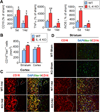Interleukin-4 Is Essential for Microglia/Macrophage M2 Polarization and Long-Term Recovery After Cerebral Ischemia
- PMID: 26732561
- PMCID: PMC4729613
- DOI: 10.1161/STROKEAHA.115.012079
Interleukin-4 Is Essential for Microglia/Macrophage M2 Polarization and Long-Term Recovery After Cerebral Ischemia
Abstract
Background and purpose: Interleukin-4 (IL-4) is a unique cytokine that may contribute to brain repair by regulating microglia/macrophage functions. Thus, we examined the effect of IL-4 on long-term recovery and microglia/macrophage polarization in 2 well-established stroke models.
Methods: Transient middle cerebral artery occlusion or permanent distal middle cerebral artery occlusion was induced in wild-type and IL-4 knockout C57/BL6 mice. In a separate cohort of wild-type animals, IL-4 (60 ng/d for 7 days) or vehicle was infused into the cerebroventricle after transient middle cerebral artery occlusion. Behavioral outcomes were assessed by the Rotarod, corner, foot fault, and Morris water maze tests. Neuronal tissue loss was verified by 2 independent neuron markers. Markers of classically activated (M1) and alternatively activated (M2) microglia were assessed by real-time polymerase chain reaction, immunofluorescence, and flow cytometry.
Results: Loss of IL-4 exacerbated sensorimotor deficits and impaired cognitive functions ≤21 days post injury. In contrast to the delayed deterioration of neurological functions, IL-4 deficiency increased neuronal tissue loss only in the acute phase (5 days) after stroke and had no impact on neuronal tissue loss 14 or 21 days post injury. Loss of IL-4 promoted expression of M1 microglia/macrophage markers and impaired expression of M2 markers at 5 and 14 days post injury. Administration of IL-4 into the ischemic brain also enhanced long-term functional recovery.
Conclusions: The cytokine IL-4 improves long-term neurological outcomes after stroke, perhaps through M2 phenotype induction in microglia/macrophages. These results are the first to suggest that immunomodulation with IL-4 is a promising approach to promote long-term functional recovery after stroke.
Keywords: flow cytometry; interleukin-4; macrophages; neurological function; stroke.
© 2016 American Heart Association, Inc.
Figures






References
-
- Hu X, Li P, Guo Y, Wang H, Leak RK, Chen S, et al. Microglia/macrophage polarization dynamics reveal novel mechanism of injury expansion after focal cerebral ischemia. Stroke; a journal of cerebral circulation. 2012;43:3063–3070. - PubMed
-
- Wang G, Zhang J, Hu X, Zhang L, Mao L, Jiang X, et al. Microglia/macrophage polarization dynamics in white matter after traumatic brain injury. Journal of cerebral blood flow and metabolism : official journal of the International Society of Cerebral Blood Flow and Metabolism. 2013;33:1864–1874. - PMC - PubMed
-
- Butovsky O, Ziv Y, Schwartz A, Landa G, Talpalar AE, Pluchino S, et al. Microglia activated by il-4 or ifn-gamma differentially induce neurogenesis and oligodendrogenesis from adult stem/progenitor cells. Molecular and cellular neurosciences. 2006;31:149–160. - PubMed
-
- Kotter MR, Zhao C, van Rooijen N, Franklin RJ. Macrophage-depletion induced impairment of experimental cns remyelination is associated with a reduced oligodendrocyte progenitor cell response and altered growth factor expression. Neurobiology of disease. 2005;18:166–175. - PubMed
Publication types
MeSH terms
Substances
Grants and funding
LinkOut - more resources
Full Text Sources
Other Literature Sources

